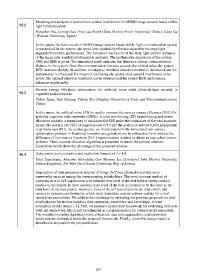Page 225 - Proceedings of the 2017 ITU Kaleidoscope
P. 225
Modeling and analysis of spatial inter-symbol interference for MIMO image sensors based visible
S5.2 light communication
Rongzhao Wu, Yarong Guo, Peng Liu (North China Electric Power University, China); Jiang Liu
(Waseda University, Japan)
In this paper, the basic model of MIMO image sensors based visible light communication system
is researched. In the system, the space inter-symbol interference caused by the stray light
degrades the system performance. The formation mechanism of the stray light and the influence
of the space inter-symbol interference is analyzed. The mathematics expression of the system
SNR and BER is given. The simulation result indicates that there is a critical communication
distance in the system. Once the communication distance exceeds the critical value, the system
BER increases sharply. In addition, an adaptive threshold detection method is introduced and the
performance is simulated. By means of estimating the spatial inter-symbol interference noise
power, the optimal detection threshold can be obtained and the system BER performance
enhances significantly.
Secrecy energy efficiency optimization for artificial noise aided physical-layer security in
S5.3 cognitive radio networks
Yuhan Jiang, Jian Ouyang, Yulong Zou (Nanjing University of Posts and Telecommunications,
China)
In this paper, the artificial noise (AN) is used to improve the secrecy energy efficiency (SEE) for
underlay cognitive radio networks (CRNs). A joint zero-forcing (ZF) beamforming and power
allocation problem is formulated to maximize the SEE under the constraints of the total transmit
power, the secrecy rate (SR) of cognitive user (CU) and the quality-of-service (QoS) requirement
of primary user (PU). As a consequence, we firstly transform the formulated non-convex
optimization problem in fractional form into an equivalent one in subtractive form, and use the
difference of two-convex functions (D.C.) approximation method to obtain an equivalent convex
problem. Then, a power allocation algorithm is presented to obtain the optimal solution.
Simulation results show the advantage of the proposed scheme.
S5.4 Data centric trust evaluation and prediction framework for IoT
Upul Jayasinghe, Abayomi Otebolaku, Gyu Myoung Lee (Liverpool John Moores University,
United Kingdom); Tai-Won Um (Chosun University, Rep. of Korea)
Application of trust principals in internet of things (IoT) has allowed to provide more
trustworthy services among the corresponding stakeholders. The most common method of
assessing trust in IoT applications is to estimate trust level of the end entities (entity-centric)
relative to the trustor. In these systems, trust level of the data is assumed to be the same as the
trust level of the data source. However, most of the IoT based systems are data centric and
operate in dynamic environments, which need immediate actions without waiting for a trust
report from end entities. We address this challenge by extending our previous proposals on trust
establishment for entities based on their reputation, experience and knowledge, to trust
estimation of data items [1-3]. First, we present a hybrid trust framework for evaluating both data
trust and entity trust, which will be enhanced as a standardization for future data driven society.
The modules including data trust metric extraction, data trust aggregation, evaluation and
prediction are elaborated inside the proposed framework. Finally, a possible design model is
described to implement the proposed ideas.
– 209 –

